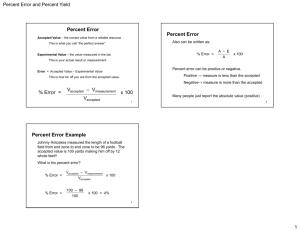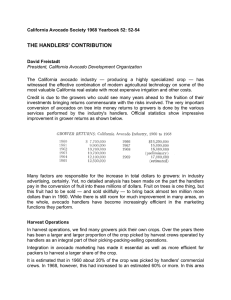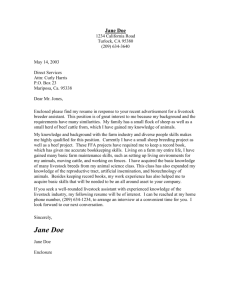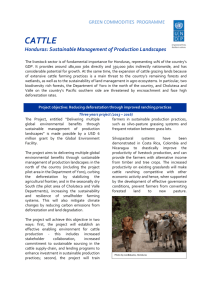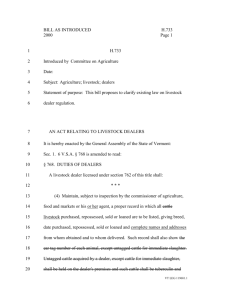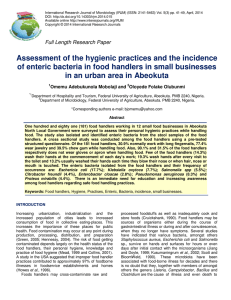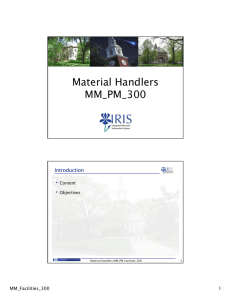Critical risk: Stock handling
advertisement
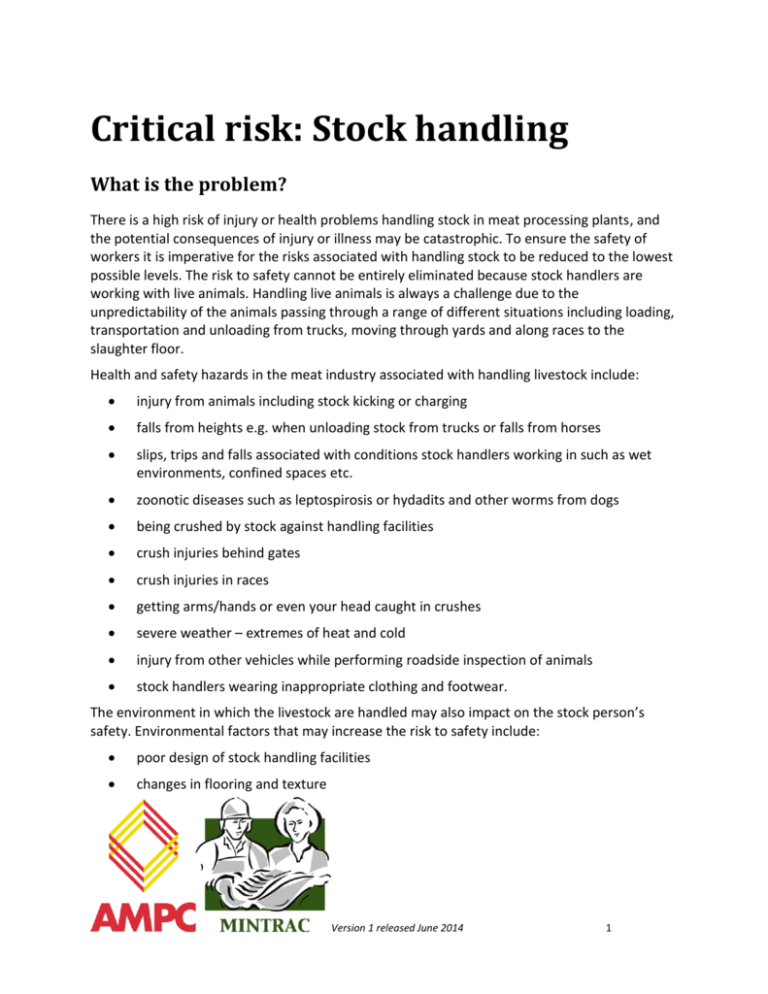
Critical risk: Stock handling What is the problem? There is a high risk of injury or health problems handling stock in meat processing plants, and the potential consequences of injury or illness may be catastrophic. To ensure the safety of workers it is imperative for the risks associated with handling stock to be reduced to the lowest possible levels. The risk to safety cannot be entirely eliminated because stock handlers are working with live animals. Handling live animals is always a challenge due to the unpredictability of the animals passing through a range of different situations including loading, transportation and unloading from trucks, moving through yards and along races to the slaughter floor. Health and safety hazards in the meat industry associated with handling livestock include: injury from animals including stock kicking or charging falls from heights e.g. when unloading stock from trucks or falls from horses slips, trips and falls associated with conditions stock handlers working in such as wet environments, confined spaces etc. zoonotic diseases such as leptospirosis or hydadits and other worms from dogs being crushed by stock against handling facilities crush injuries behind gates crush injuries in races getting arms/hands or even your head caught in crushes severe weather – extremes of heat and cold injury from other vehicles while performing roadside inspection of animals stock handlers wearing inappropriate clothing and footwear. The environment in which the livestock are handled may also impact on the stock person’s safety. Environmental factors that may increase the risk to safety include: poor design of stock handling facilities changes in flooring and texture Version 1 released June 2014 1 dark race entrances causing stock to balk and increasing the risk to stock handlers time of day, e.g. light and wind may affect the way stock behave. How can stock handling be made as safe as possible? Work health and safety laws mandate that senior management must take a risk management approach to minimise the risks to health and safety in the workplace. This involves taking a systematic approach to identifying all the risks associated with every hazard in the workplace and implementing control measures to eliminate the risks or, if that is not possible to reduce the risks to the lowest possible level. Stock handlers are working with live animals so the risks cannot be eliminated but it is crucial for senior management to implement the most effective control measures in the work areas to reduce the risks to stock handlers to the lowest possible levels. For example, re-design of yards, lairage, races etc. and separating stock handlers from the animals as much as possible are effective control measures. Hierarchy of control measures Effectiveness Types of control Most effective Elimination Examples Substitution Isolation Limit handling of high risk animals, but NEVER isolate livestock as they will become stressed and unpredictable. Engineering controls Ensure manways are available in yards and laneways. Administrative controls Ensure stock handlers are competent in their jobs. Design catwalks or walkways along yards and laneways so handlers do not have to be in with the livestock when moving them. Ensure stock handlers have health and safety training particularly in risk management. Ensure instructions and SOPs are up to date. Monitor housekeeping and cleaning. Version 1 released June 2014 2 Least effective Personal Protective Equipment Wear appropriate clothing, footwear and bump hats. Even with control measures in place to design out risks and separate stock handlers from animals as much as possible, stock handlers are still constantly interacting with animals. It is therefore crucial for stock handlers to be competent in their jobs. This includes competency and experience in animal handling, animal welfare and health and safety. They must also be alert at all times. Because they are working with live animals they should always assess the animals before they work with them. This includes assessing: breed and size physical attributes that may cause injury (horned cattle versus poll cattle) gender – bulls tend to be more aggressive than cows physiological state – are the cattle nurturing calves or separated from the herd background of the cattle – are cattle familiar with handling. Stock handlers need to be taking a risk management approach to their work at all times. Before they do any task they must not only assess the stock they are working with but also: look around them and identify and fix any hazards that might increase the risk of what they’re doing, e.g. identify a means of escape if an animal charges them, check housekeeping in yards before stock enter assess the situation and work out how to minimise the risks of what they’re about to do judge whether it is too dangerous to do the task and if they feel it is too dangerous discuss this with their supervisor perform the task once they’ve minimised the risks review the task after they’ve done it and assess whether there is anything they could do differently to minimise the risks in the future, and report any issues to their supervisor. Stock handlers must also follow workplace procedures at all times. Procedures will include: wearing appropriate Personal Protective Equipment (PPE) eyewear and masks when dealing with known leptospirosis carriers and brucella reactors and wearing bump hats wearing appropriate footwear using walkways and gantries where provided Version 1 released June 2014 3 being aware of animal location at all times knowing the location of exit gates, ladders and steps vaccination against zoonotic diseases parking vehicles in safe locations (level, off the road, away from traffic) accessing vehicles from the non traffic side wearing gloves to prevent the spread of disease from animal to human if the animal is suspected of having a contagious disease maintaining fluid intake during hot weather. Issues that stock handlers need to be aware of to minimise the risks to health and safety include: the normal behaviour patterns of the livestock eg how they will respond to movement and the flight zone handling requirements for different ages, sex, breeds, for example Brahman or other northern cattle the need to move animals quietly and calmly, without causing fear or excitement ensuring animals have sufficient space to move into, eg from the open to the race the correct use of implements such as goads or prodders (overuse will excite livestock and make them unpredictable and dangerous) the layout of yards, such as gates, exits and races, in case they need to get out of the way suddenly problems relating to the physical surroundings, such as wet conditions, broken gates and poor lighting. What are my responsibilities as a supervisor? As a supervisor your responsibilities are at two levels. You have responsibilities as a manager and you also have responsibilities as an employee. At the supervisor level of management you are responsible to implement the systems, policies and procedures in your area and with the team that you manage. As an employee you are responsible to set an example for your own team and model exemplary behaviour that demonstrates what your team must do to work safely, comply with the law and help make the working environment for your team as healthy Version 1 released June 2014 4 and safe as possible. These are legal responsibilities. If you do not meet your legal responsibilities you may be faced with serious consequences including fines. If you do your job you will be ensuring your work area is as safe as it can be. Working with live animals is always a challenge with a degree of risk associated with it. You need to be constantly on the alert and taking a risk management approach to everything you do. You should also be working with your team to ensure they too are taking a risk management approach to their work. This involves conducting pre and post op checks including: constantly identifying and fixing hazards before they cause problems assessing situations and making judgments about risks identifying and implementing control measures to minimise risks reviewing situations and tasks to ensure you achieved the best possible outcomes with the lowest possible risks to your team members. You need to have a good relationship with your team ensuring that they are competent in all aspects of their job including health and safety. You are constantly monitoring your team to ensure they remain alert, follow SOPs and other work procedures but also show initiative when needed to get out of difficult situations with stock, and provide appropriate support for team mates as required. You will also provide your team with opportunities to talk together as a team about how they managed situations and improvements that could be made. How do I find further information? You should be able to find additional information in your own workplace in documents such as standard operating procedures, work health and safety manuals or human resources manuals. You can go to your own manager, the WHS manager, the HR manager or the WHS committee. This factsheet only provides you with an overview of health and safety in regard to reducing risks of handling stock. For further information you should refer to the relevant legislation in the area. To do this you should go to the work health and safety authority in your state and search their website for relevant material: WorkCover NSW - www.workcover.nsw.gov.au Workplace health and safety Queensland - www.justice.qld.gov.au/fair-and-safework/workplace-health-and-safety Worksafe Vic - https://www.worksafe.vic.gov.au Version 1 released June 2014 5 SafeWork SA - www.safework.sa.gov.au WorkCover WA - www.workcover.wa.gov.au WorkCover Tas - www.workcover.tas.gov.au You may also go to the national work health and safety authority responsible for reforming WHS legislation. This is Safe Work Australia (www.safeworkaustralia.gov.au). AMIC and the AMIEU also have information including: AMIC WHS and Workers Compensation database AMIC National Animal Welfare Standards at Livestock Processing Establishments Producing Meat for Human Consumption (http://www.amic.org.au/SiteMedia/w3svc116/Uploads/Documents/829d68cf-f1774602-aeebcf23db0e54a2. pdf) Other publications include: AHCLSK205A Handle livestock using basic techniques Stock handling in the meat processing industry kit available from MINTRAC. Beef Cattle Handling: A Practical Safety Guide, WorkSafe Victoria, 2004 Version 1 released June 2014 6


